The anatomy of marketing funnel automation
Competitive marketers can no longer opt out of martech to automate processes. Instead, you can leverage automation for maximum efficiency and scalability.
Competitive marketers can no longer opt out of martech. It is the tool that enables them to work smarter, scale faster, and get more done with less effort.
AI. Big data. Personalization at scale. Marketers are expected to deliver tailored content for a wide audience, converting leads into customers and tracking every interaction—all while optimizing costs and efficiency.
So what’s the solution to get this done?
This is where marketing funnel automation comes to the rescue.
By using advanced martech tools, you can effectively streamline and optimize your entire customer journey, and the results speak for themselves. Companies who have successfully deployed and integrated these tools and automations have experienced the following:
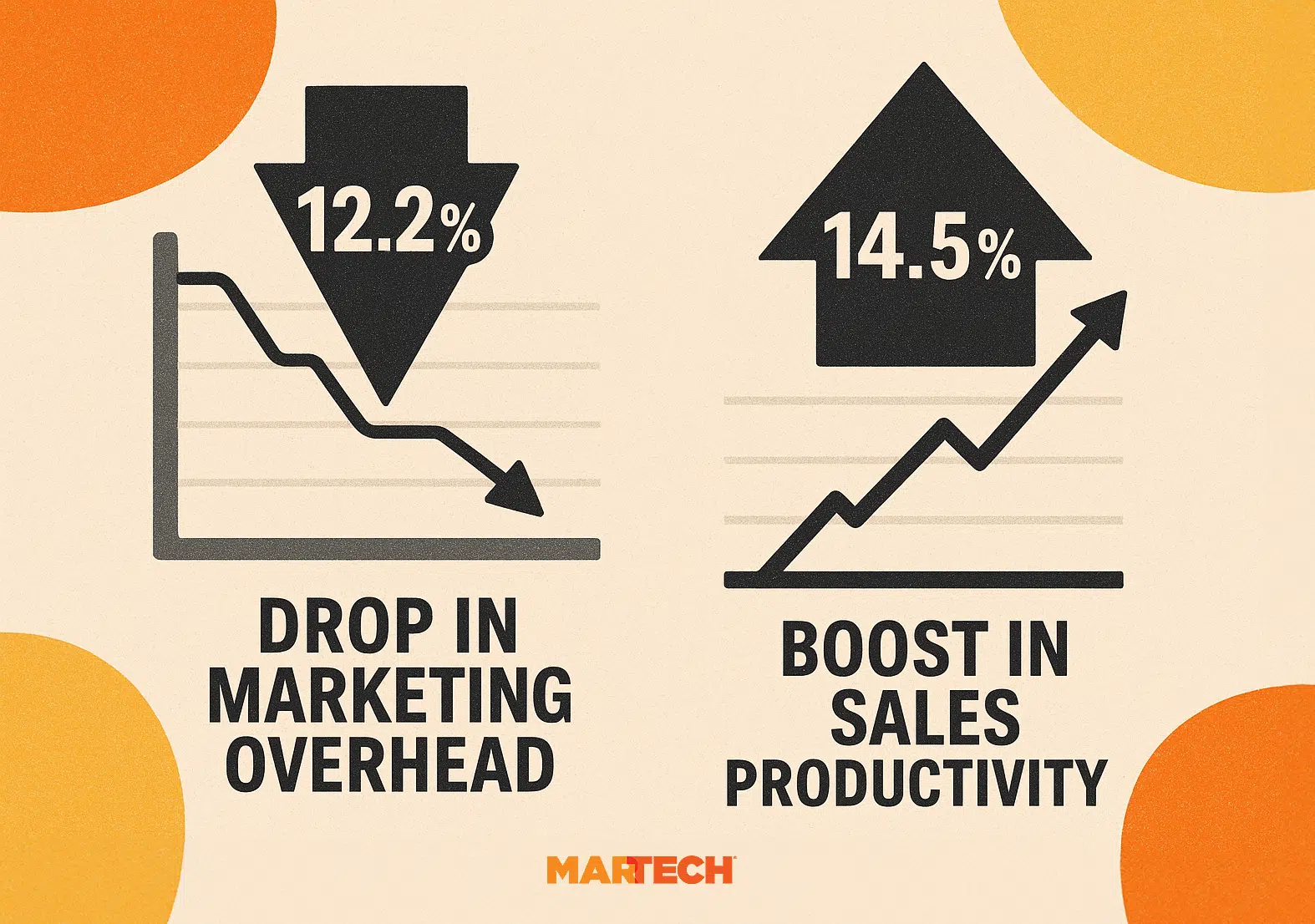
Impressive, right?
Before we reveal how you can achieve similar results, let’s dive into what makes up the anatomy of a successful marketing funnel automation.
What is a marketing funnel?
A marketing funnel is the path people follow from first finding your brand to the point where they choose to buy from you. The journey goes from awareness to interest to trust and finally to action (specifically, transaction).
Typically, it works like this: Someone sees your brand on social media. Maybe they click through to your website or sign up for your newsletter because something resonates with them. Over time, as they engage with your content, they get a clearer sense of what you offer.
Once they recognize the value you provide and see how it fits their needs, trust and connection is built. And when the time is right—when the day comes that they need exactly what you offer—they are more likely to make a purchase because your marketing has already built that sense of familiarity and confidence.
During the marketing funnel, there are several stages the customer will move through:
- Awareness: The person’s opinion of your brand is a blank slate. They don’t know what you do, but they know you exist.
- Interest: Guided by curiosity, the potential customer looks into your business. Perhaps they browse your website to learn more about your work.
- Consideration: You have piqued their interest, and they might compare your brand to others or go through reviews. They are thinking about you.
- Intent: This is the beginning of the action phase. They’re almost ready to close, but a little nudge might be necessary.
- Purchase: The customer takes a leap and invests in your business; they might have bought something or signed up for your service.
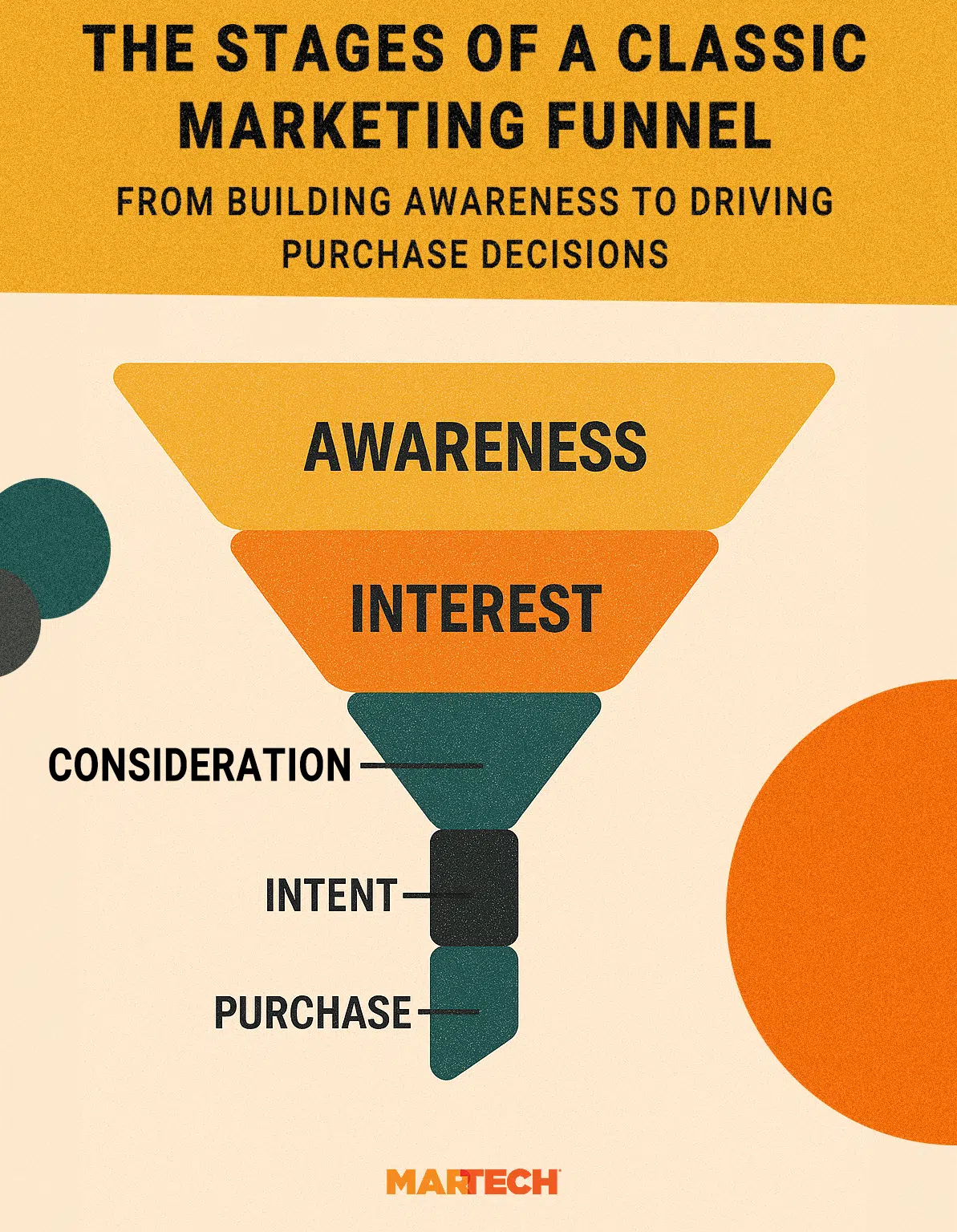
Technically, you also have retention, where existing customers are nurtured to remain loyal customers, which can look like referring new leads or even upselling products or services.
Why do marketing funnels matter?
It’s one thing to know what a marketing funnel is, but do they actually matter? Won’t people just buy what they need when they need it?
Not quite. By understanding how marketing funnels work, you can better develop a strategy for hooking your audience.
You might know how your audience could benefit from your brand, but you need to shift their curiosity into conversion. That’s why it’s essential to have the right message for the right people at the right time.
How do you do that?
Data.
Through monitoring the marketing funnel, you’ll have access to valuable data on the customer experience at each stage. Your wins and losses. They allow you to see what to keep, adjust, and eliminate so that you convert more customers along the funnel.
For example if you see lots of people dropping off after downloading your lead magnet, it might mean your next email isn’t hitting the mark—or it’s arriving too late.
The end result is messaging and content that doesn’t just convert—it retains.
Marketing funnel vs. sales funnel
Now, it’s important to remember that a marketing funnel is different from a sales funnel.
Marketing is what brings potential customers in. Sales is what gets them over the line.
For example, someone hears your brand mentioned on a podcast. They’re intrigued, so they follow your account, browse your content, or sign up for your newsletter. Over time, they learn more, become familiar with what you offer, and begin trusting your expertise. Later, when they’re ready to make a purchase or decision, they’re already warmed up and confident in your brand, making it much easier for your sales team to close the deal.
Marketing warms them up, builds trust, and starts the conversation. And then sales steps in when they’re ready to buy.
Think of it this way: Marketing funnels include comprehensive, long-term strategies focused on brand awareness and nurturing potential customers, while sales funnels focus on short-term strategies aimed at closing the deal.
For your business to succeed, the relationship between both teams needs to be as seamless as possible. That’s when you’ll achieve great results.
Why automate your marketing funnel?
No matter the context, automation is almost always the key to efficiency. With marketing funnels, automated workflows are often what separates a competitive marketer from one who’s just getting by.
You can expect the following benefits from automating your marketing funnel:
1. Save time on repetitive tasks
Tasks within the funnel tend to be repetitive, and when you lean on automation, you remove the busywork like manually tagging leads, setting up email blasts, or copying contact details from one tool to another. You’ll get more time to focus on strategy development while automating tasks like lead tracking and email scheduling.
2. Nurture leads effectively
Want to keep your leads warm? You need content. Through automation, you’ll always serve leads content that’s helpful and relevant to their funnel stage so you can nurture them toward conversion.
Let’s say someone downloads your pricing guide. You can follow up with an email containing a case study that shows exactly how your product delivers ROI.
3. Get better data and insights
As your automation provides real-time visibility, you’ll have an overview of what’s occurring at each stage. You’ll be better able to track every touchpoint, learn where drop-offs occur, and understand what’s wrong.
The advantage: constant refinement for better success.
4. Align marketing and sales
To convert and retain customers, the marketing and sales teams need to collaborate. With automatic access to better data, the marketing team can feed sales high-quality information, ensuring you meet your goals through enhanced visibility. This might include relaying a lead’s product interests or the content they most recently clicked on so that the sales team can tailor their pitch.
Understanding how to automate your funnel
What is marketing funnel automation?
Marketing funnel automation is relying on technology to automatically guide customers through the buyer journey.
By replacing manual marketing tasks with automated tools, you’ll deliver a personalized, data-driven experience at each stage of the funnel. The result? A seamless process for your customers, from the first click to the final sale.
For example, let’s say someone signs up for your newsletter after they heard you on a podcast. Along with the newsletter, they’re automatically enrolled in a three-part welcome sequence. That very first email? It gives you a tiny glimpse into what might keep them coming back for more.
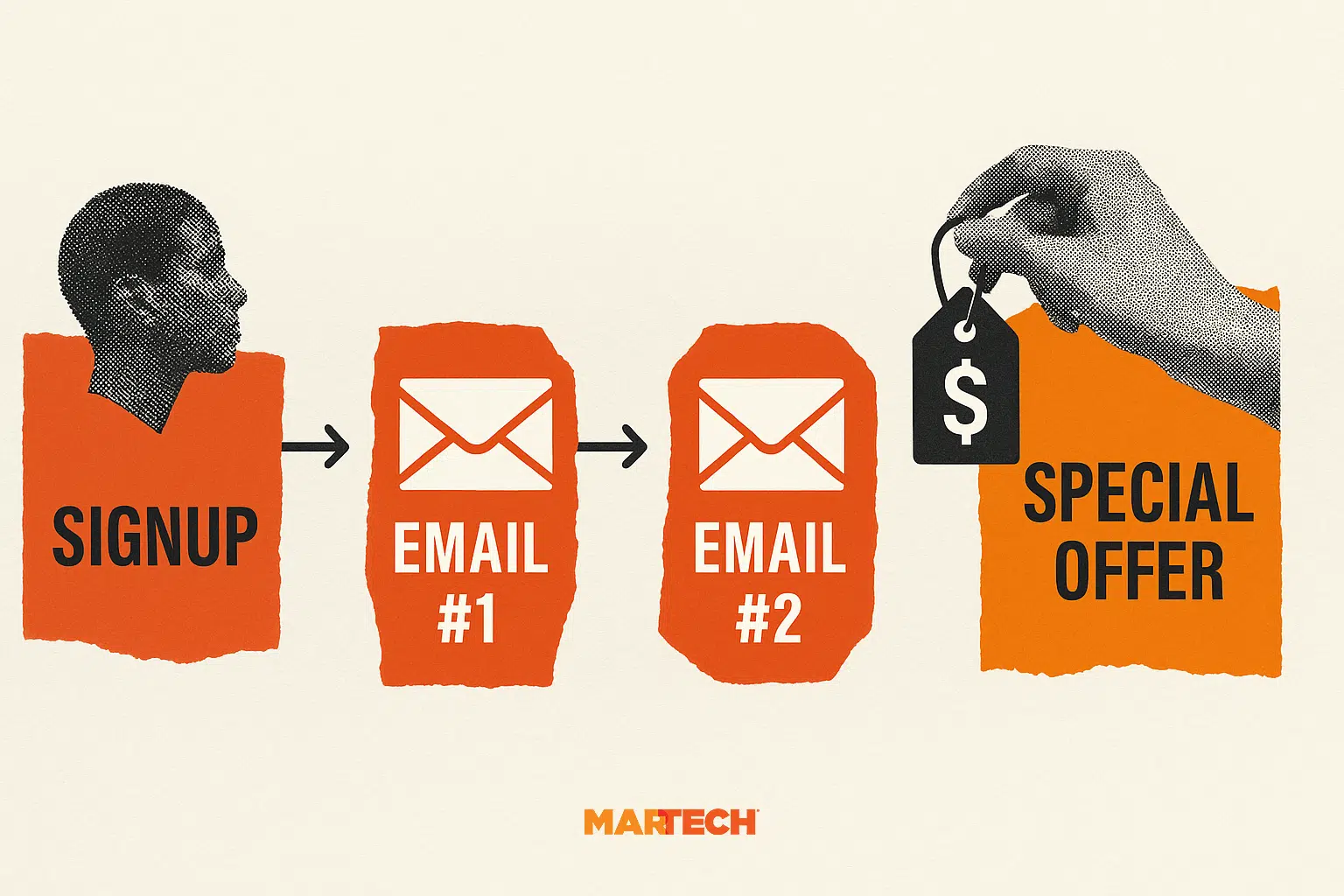
Based on how they engage, each email in the sequence is timed and tailored to their interests. Your emails serve as a gentle nudge forward, each message helping them feel seen, understood, and valued.
Why automation is critical for successful marketing
Automation simplifies your marketing process, cuts down on your manual tasks, and helps you scale your marketing efforts. Here are the benefits it unlocks:
1. Increased efficiency and scalability
Automating your funnel reduces the bottlenecks that previously meant more admin tasks for your team. Spending time manually updating contact records, setting reminders to follow up, or exporting weekly reports can be a thing of the past. Getting rid of these choke points enables you to create impactful campaigns without the headaches of scaling with manual processes.
2. Better lead nurturing and conversion rates
Personalization becomes a whole lot easier through targeted workflows. You’re able to serve up the right content at the right time, nudging people to buy based on what they’ve shown they like. For example, if someone’s been checking your beginner-level content, you can guide them to a simple starter package that fits.
3. Stronger marketing and sales alignment
Part of the struggle of the marketing and sales collaboration occurs during the handoff process. Automation makes this process smoother by sharing the right context at the right time, so sales knows exactly when and how to step in.
4. Data-driven decision making
Having real-time insights gives you more freedom to test, tweak, and optimize your messaging. As a result, you can make smarter improvements based on what actually resonates with your audience. You might notice that emails with real customer stories get more clicks, that’s your cue to lean into what’s working and keep sharing proof that builds trust.
Key parts of funnel automation
Customer data and audience segmentation
Effective funnel automation starts with smart segmentation. By leveraging real-time data, marketers can group audiences by the following categories:
- Demographics
- Purchasing behavior
- Engagement patterns
- Testing outcomes and emerging trends
So how does automation get you there? First, AI and machine learning can identify big data trends and patterns that manual analysis may overlook. You can focus on internal data or incorporate external data.
Where does this data come from?
Behold, the customer data platform (CDP). This is not a CRM or DMP; it’s a tool for unifying data from everywhere to power automation.
CDPs consolidate customer data from various sources, enabling precise segmentation while maintaining data security and hygiene, as well as streamlining collaboration.
Automated content delivery
Automating content delivery ensures that the right messaging lands with the right audience at the right time. Smart marketers iterate on their automation, integrating insights they’ve gained and expanding the granularity and sophistication of how they target.
You may have heard this referred to as “dynamic content personalization,” which includes common use cases like:
- Delivering tailored emails at optimal times based on user behavior
- Serving personalized ads to retargeted users
- Maintaining messaging consistency across email, social media, and paid channels
New subscribers? Enroll them in a smart welcome sequence with targeted content based on their previous engagement.
Cart abandoners? Hit them with a discount they can’t resist. You can run A/B tests that quickly achieve statistical significance given the scale you can leverage here.
Lead scoring and qualification
Lead scoring involves assigning value to leads based on their likelihood to convert.
AI-powered predictive analytics has transformed this process so that marketers can now:
- Score leads based on historical and behavioral data
- Prioritize high-value prospects for the sales team
- Rapidly clean up even the largest databases and maintain data hygiene
Once again, we see marketing automation contributing to scale and resource management. Better lead scoring means you prioritize the leads most likely to convert, focusing your marketing and sales teams’ efforts where they can deliver the greatest impact.
Nurture campaigns
Whether you’ve built them or received them in your own inbox, everyone is familiar with drip campaigns: the automated sequence of messages sent to potential customers based on their previous engagement and demographics.
Seamless drip campaigns guide users naturally. Poorly built drip campaigns feel pushy and miss the mark.
Drip campaigns are a hallmark of funnel automation, guiding leads through the customer journey with timely and relevant content. For optimal results, focus on refining:
- Conditional triggers: Set smart actions in workflows to automatically send emails or messages. What user actions matter most? Link clicks or downloads to trigger tailored responses.
- Lifecycle stages: Build custom campaigns tailored for users at distinct buying stages, from awareness to decision-making. Different information will resonate at each stage, but your custom campaign will ensure the right information is visible at the right time.
Analytics and optimization
We all know that when it comes to anything tech, “garbage in equals garbage out.” Taking a proactive approach to improving analytics and honing your optimizations can determine how successful you are against your competition.
You already know about the power of good data hygiene, but have you considered how you access and manage that data?
Centralized dashboards can consolidate data input so you can more effectively monitor performance metrics across all channels.
How about generating data to directly report on the direction of your campaigns?
You can automate A/B testing to evaluate multiple variants of emails, ads, and landing pages at a grand scale. Determine what works best using data that reflects your actual marketing content and your real-world audience.
SmileWorks Grew 24X While Cutting Ad Spend 90% with Semrush Keyword Research
✓ Find high-intent keywords competitors miss
✓ See exactly which terms convert visitors to customers
✓ Discover untapped traffic opportunities specific to your market
Free instant insights.
Build your martech stack for funnel automation
Integrate the right tools
Your marketing funnel automation is only as effective as your martech stack.
The right martech enables you to scale, streamline, and gather insights that deliver results. Here are a few tools you’ll want to consider as you scale up your efforts and insights:
Marketing automation platforms (MAPs)
Your marketing automation platform is the central hub of your funnel automation efforts. Some common examples include HubSpot, Marketo, and ActiveCampaign. These platforms allow multiple users across teams to collaborate around email marketing, lead capture, and high-level reporting.
Customer relationship management (CRM)
Your customer relationship management tool is the central repository of customer information, spanning buying stages (and even including untouched prospects). Here you can track engagement over time.
Again, the smarter you are about what data you collect—and how you get it—the better your insights and the more effective your marketing can be. The cornerstone of a CRM is the ability to know everything about—and manage—individual interactions.
Customer data platforms (CDPs)
Your CRM gets granular, but your customer data platform goes macro by combining data from different sources into a unified customer profile. Tools like Segment and BlueConic aggregate this data, giving you a high-level overview of customer behavior and preference. This allows you to better understand your target audiences and readily pinpoint opportunities for improvement.
Analytics tools
Raw data is great, but even better are the insights you can glean. Tools like Google Analytics and Hubspot help you turn data into actionable insights and understand funnel performance at every step of the customer journey. These tools empower you with data visualizations so you can share your findings with other teams and help your entire organization align around next steps and the needs of your ideal customers (and their real-world realities).
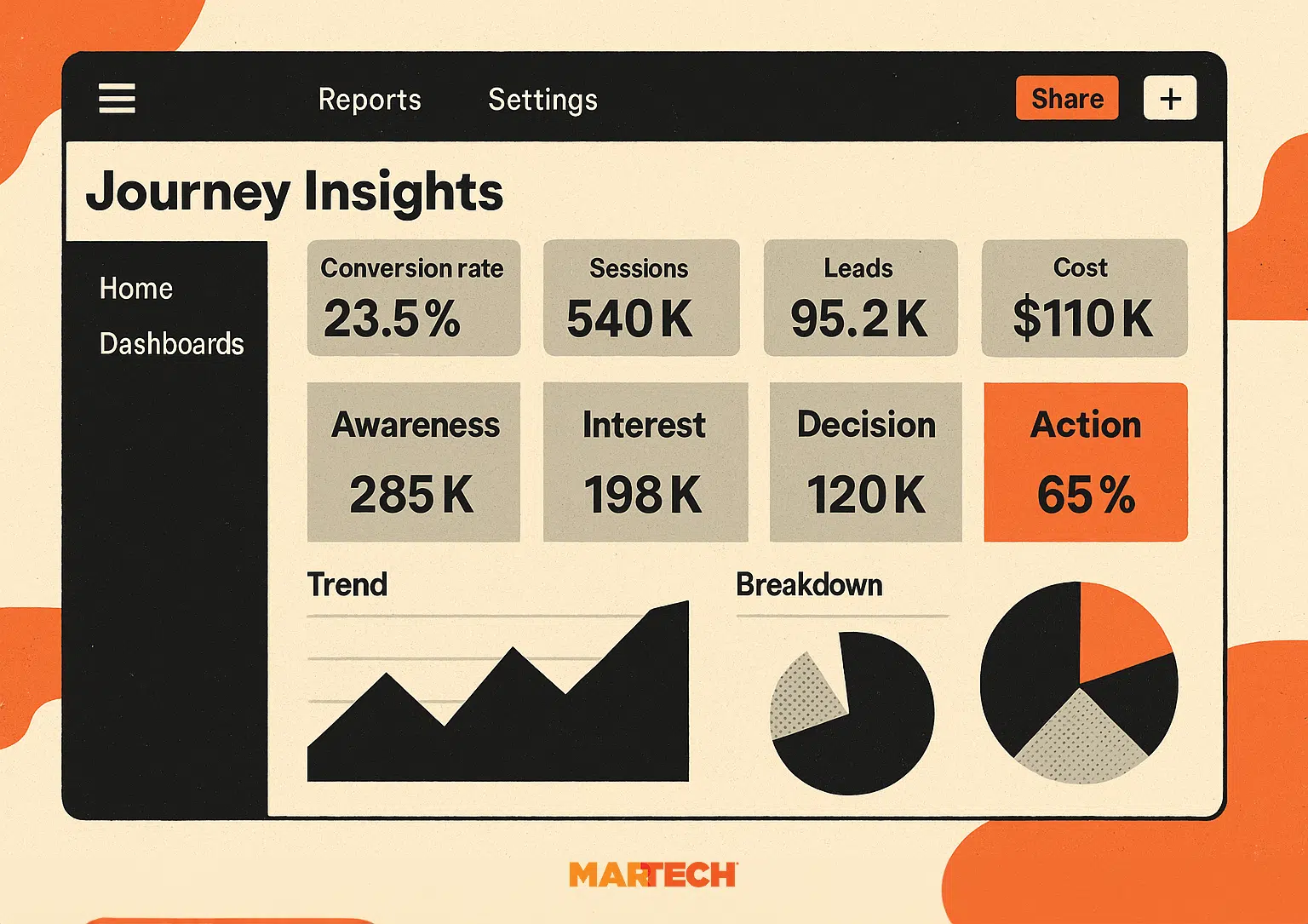
AI-based personalizations
With the help of AI-based personalizations, you can suggest relevant products or services and meaningful content to your users.
Welcome to one of the hottest trends flowing out of the AI revolution: personalized content. Whether it’s tailored content, a stronger call to action, or product recommendations based on previous engagement, using AI to facilitate customized experiences for each user is the latest trend—and it’s quickly gaining adoption, since there’s a ton of data supporting its impact on driving conversions.
Conversational AI
AI-powered chatbots guide leads through the funnel by offering real-time, tailored support, even when your team isn’t available. These chatbots speak in plain English that reads like natural language. You can incorporate lead-capture forms that vary based on the individual’s questions or engagement, adding another layer of offering up the right content at the right time.
Chatbot interactions will typically look like this:
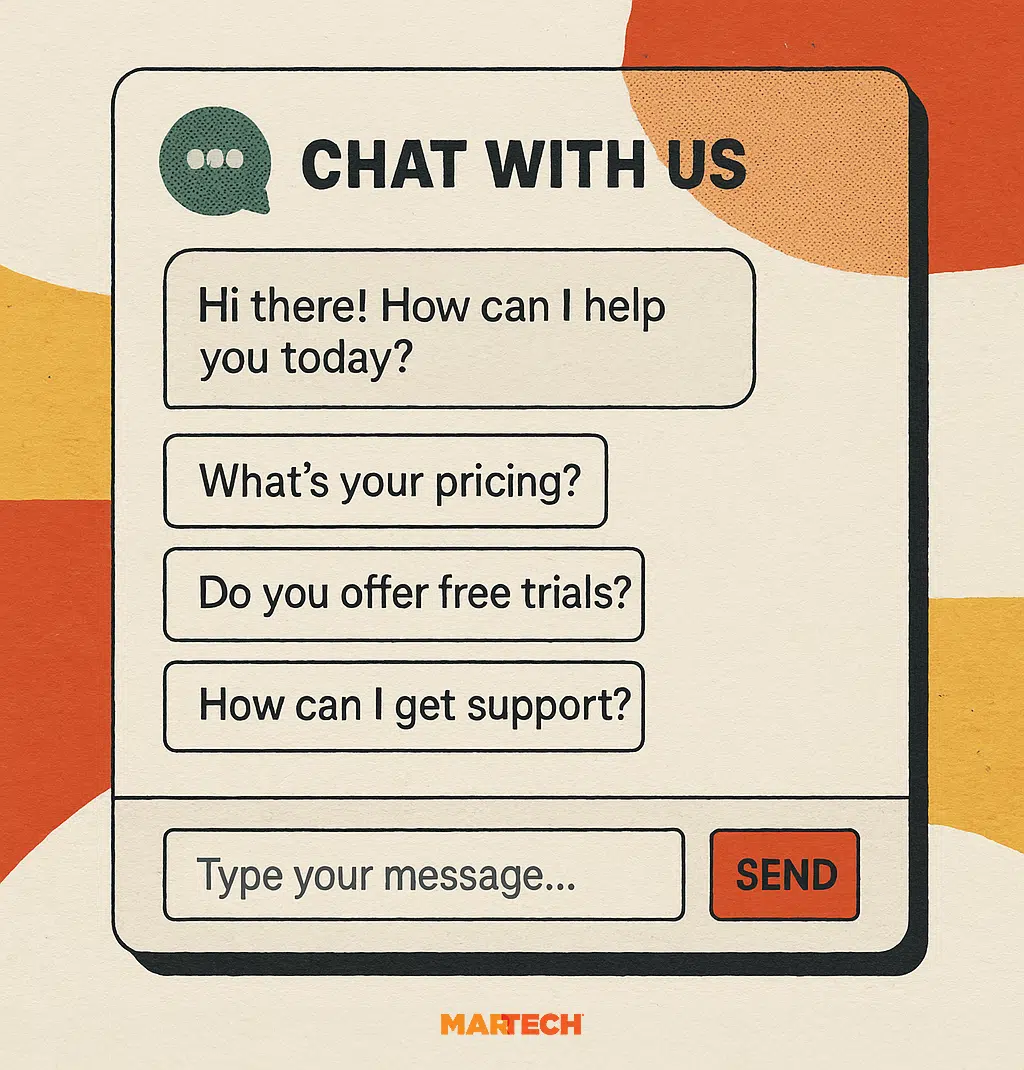
Leverage APIs wherever possible
Seamless integration between tools is key to successful automation across your marketing enterprise. By taking advantage of application programming interfaces (APIs), you can streamline data from a wide range of sources and simplify cross-functional collaboration. Selecting tools that offer and incorporate API connections enables your various tools and systems to communicate with real-time data synchronization, creating efficient workflows.
For example, you might connect Facebook Ads Manager to your MAP to retarget users who clicked on an ad but didn’t convert, directly and automatically entering them into a nurture sequence.
An added bonus to API integration is error reduction, since data is directly turned over across platforms without any need for manual touch. Data hygiene benefits from consistency across platforms, too.
Map automation to customer journeys
Mapping automation is the process of setting up automated systems that align with specific actions or stages in a customer’s journey. This involves leveraging data. Real-user behavior is always valuable as it paints a more complete picture of what your audience wants, instead of relying on assumptions from your team.
There are three ways you can move towards understanding what to feed your audience:
- Awareness: What evokes curiosity? Maybe it’s a blog post or a short intro video. The content you serve them is based on how they first found you—whether it was a scroll, a click, or a follow.
- Consideration: Once potential customers show interest, they want to learn as much as they can. This is where case studies, testimonials, or comparisons come in handy. With automation, you can tailor content based on what they have engaged with.
- Decision: They’re thinking of making the leap, but they need you to guide them over the finish line. When they revisit your pricing page or open emails, that’s your cue. Deliver strong calls to action (CTAs), product demos, a free trial, or anything that makes the “yes” feel easy.
Test and iterate workflows
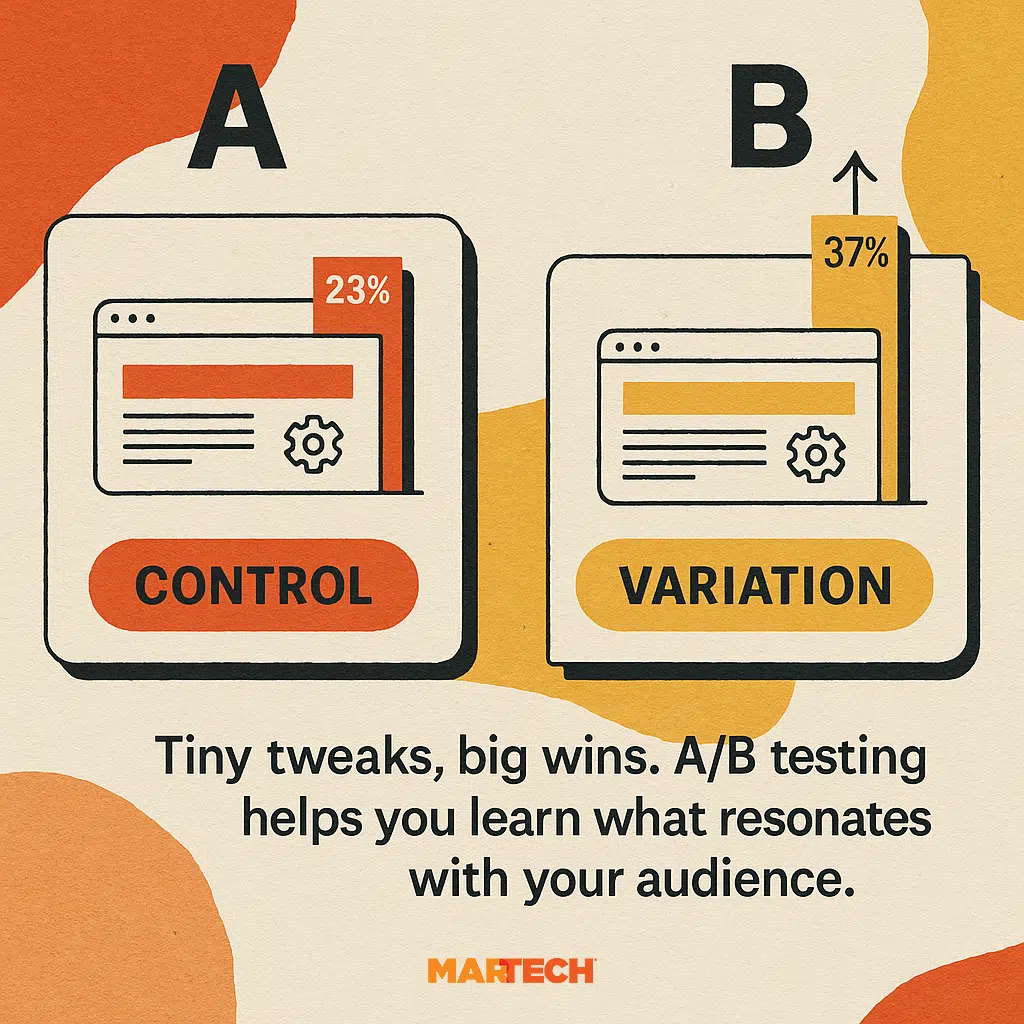
Testing and iterating your workflows is a process that makes magic happen.
How else will you know what’s working and what’s not?
Testing is about running little experiments: swapping a subject line, shifting your timing, or playing with different CTAs. This is where A/B testing is vital.
Let’s say two different potential customers sign up for your newsletter. You send them each a welcome email. One version might have a discount. The other offers a free gift with purchase. You’ll watch to see which one converts better and implement your findings.
Then comes iteration. Tweaking, refining, and improving are key. You don’t guess; you learn from what lands.
Use your data to see what wording and timing hit their marks and for whom. Leaning into this is when conversions start flowing.
Balance automation with human touch
Automation is powerful. It gives you data, efficiency, and insight. But your audience needs human connection to convert.
That’s where balance comes in. Yes, rely on automation to do the heavy lifting. However, you need to keep the human touch alive. Use real names and personalize check-ins during the customer journey.
If someone shows strong intent, don’t leave them hanging in a workflow. Make a call or send a message—a way for them to get that human connection. It’s what sticks with them and will make them want to come back for more. Remember, emotion is what makes things memorable.
Get a competitive edge with emerging technologies
Curious about what’s coming next? Incorporating emerging technologies into your marketing funnel automation can further sharpen your competitive edge.
One area experiencing ongoing growth is predictive analytics, as the sophistication of processing power continues to grow. The newest algorithms provide advanced forecasting capabilities so you can take a more proactive approach to your marketing. You can couple this with generative AI to automate content creation across your channels.
Even blockchain technology shows promise in facilitating data security and transparency.
Enterprise marketing cannot opt out of marketing funnel automation, or else you miss out on the efficiency, scalability, and precision needed to stay competitive. The good news is that current martech tools and strategies are focused on supporting the delivery of personalized experiences at scale. Your team will benefit from proven strategies and tested tools.
As you work to refine your marketing automation, start by mapping out and auditing your current funnel for opportunities to embrace the newest tools. No aspect of marketing is beyond the scope of automation, which in turn buys you more time to be strategic.
SEO is no exception. With Semrush Enterprise, you get an all-in-one solution for the most advanced reporting and automation, generative AI resources, and high-speed collaboration with vetted experts.
New on MarTech